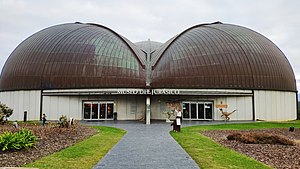 Exterior view of Jurassic Museum of Asturias | |
| Established | March 2004 |
|---|---|
| Location | Principality of Asturias File:Flag of Asturias.svg |
| Coordinates | 43°30′07″N 5°16′29″W / 43.501897°N 5.274769°W |
| Type | Palaeontology of Mesozoic divisions of Cretaceous, Jurassic, and Triassic periods |
| Visitors | Over 1 million[1] |
| Website | Official website |
The Jurassic Museum of Asturias (Spanish: Museo del Jurásico de Asturias; MUJA) is located in the area of Rasa de San Telmo near the parish (administrative division) of Llastres in the municipality of Colunga, Asturias, Spain. Though the municipality of Ribadesella was initially proposed, Colunga was chosen for the building site in the late 1990s.[2] Several landmarks are visible from the museum including the Bay of Biscay, the Sierra del Sueve, and the Picos de Europa. Strategically located over a mount on the Rasa de San Temo, the museum is in the midst the Jurassic Asturias.[3]
The museum displays and collections cover 3,500 million years, and although they emphasize the three stages of the Mesozoic (Triassic, Jurassic and Cretaceous), information is also presented on the preceding and subsequent periods.[4] Different stages of the Jurassic geologic period and system are on display. Corridors contain over 20 dinosaur replicas; measuring over 12 metres (39 ft) in height, their weight would exceed ten tons if the replicas were real. A rich collection of footprints and fossils found in the Asturian Jurassic coastline from ten paleontological sites are exhibited in the exposition halls and are said to be "the most complete informative and representative collection of dinosaur remains in the world."[3]
Founded March 31, 2004 and representing an investment of 12 million euros,[4] MUJA belongs to the Asturian network of public museums.[5] The museum's goal is to illustrate the factors involved in the composition of life on Earth.[6] The palaeontologist José Carlos García-Ramos from the University of Oviedo[4] leads the museum's scientific team.[1]
- ^ a b "El Museo del Jurásico de Asturias alcanza el millón de visitantes". elcomerciodigital.com (in Spanish). July 24, 2010. Retrieved 19 March 2011.
- ^ "El Museo de Tito Bustillo, el final de la lucha" (in Asturian). La Nueva España. March 15, 2011. Retrieved 19 March 2011.
- ^ a b "Jurassic Museum of Asturias (MUJA)". Government of the Principality of the Asturias. Retrieved 19 March 2011.
- ^ a b c Cuartas, Javier (April 14, 2004). "El museo del jurásico de Asturias presenta su colección de dinosaurios" (in Spanish). El Pais. Retrieved 19 March 2011.
- ^ "EL MUJA, un edificio EMBLEMÁTICO". asturiasnatural.com (in Spanish). Retrieved 19 March 2011.
- ^ "The Jurassic Museum- MUJA Dinosaurs in Asturias". desdeasturias.com (in Spanish). Retrieved 19 March 2011.
